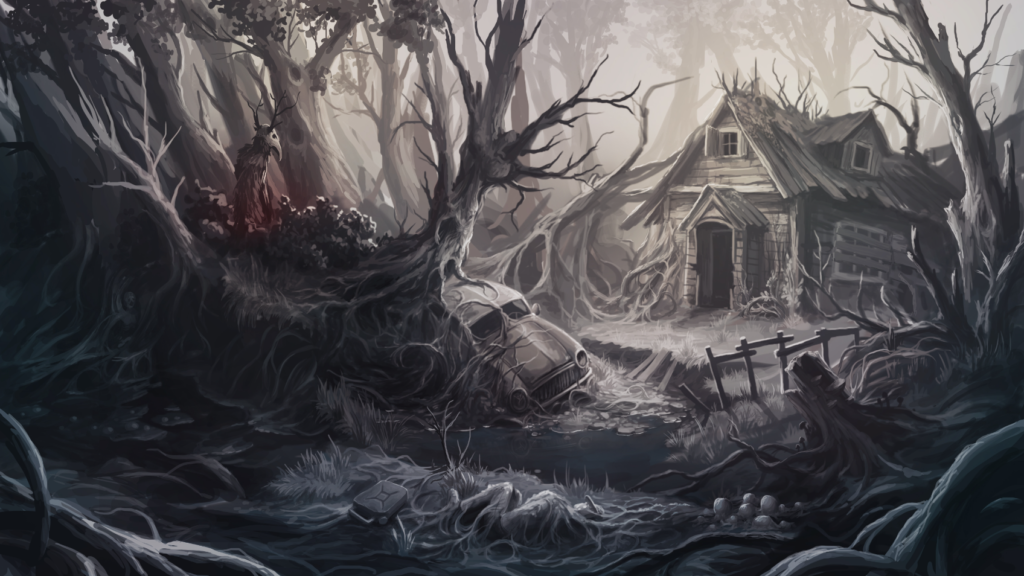Played on an LG C3 55” OLED Display via Steam, AMD 7900 XTX and i9-10900k. Also played on a Steam Deck for a 2nd playthrough.
Publisher: Grasshopper Manufacture Inc.
Developer: Grasshopper Manufacture Inc.
Looking back, the mid-2000s and early 2010s feel like the last breaths of freedom in gaming culture. By the mid-2010s, corporate interests and focus groups had taken over, steering game design toward maximizing appeal to the widest possible audience. Risks became rare—provocative jokes and niche target audiences gave way to safe, homogenized experiences. But Shadows of the Damned, originally released in 2011, stands as a relic of that bolder era. Now, with its “Hella Remastered” edition, it managed to whisk me back to my teenage years.
The game opens with a literal bang. Garcia Hotspur, demon hunter extraordinaire, executes a demon he’s been chasing and heads home to his beloved Paula. But things quickly turn nightmarish. A scream, a crash, and Paula is revealed—hanging from the rafters—before the Demon King, Flemming, drags her soul to the underworld. Determined to save her, Garcia plunges into Hell alongside his trusty companion, Johnson—a wisecracking, skeletal demon head that can transform into various weapons and tools. Together, they embark on a road trip-style journey through the underworld, with Flemming’s towering castle ever-present on the horizon as the ultimate destination.

The world design is a feast for the imagination. Shadows of the Damned paints Hell as a realm of cold darkness, accented by striking contrasts of vibrant reds and purples with dark grays and blues. It’s not the fire-and-brimstone Hell you might expect. Each of the game’s five chapters offers a distinct atmosphere: the eerie cobblestone roads and european homes near the highway, the grotesque yet vibrant flesh markets serving delicacies of various human and animal meat, and the neon-lit entertainment district adorned with bizarre demon art showcasing their carnal desires and perverted tastes. The environments feel cohesive yet diverse, keeping the visual experience fresh even though the overall color palette remains consistent.
Gameplay mirrors this variety, often shifting genres or introducing new mechanics to keep players on their toes. One moment, you’re navigating a graveyard before being chased into entering a claustrophobic cabin in a cheeky homage to The Evil Dead where you will have to defend yourself from invaders bursting through windows. The next, you’re sniping skyscraper-sized demons with your “Big Boner” rifle or tackling a 2D shoot-em-up sequence through 2D art. Though largely linear, these try to ensure the experience never feels stale.

This is where the game’s sense of humor becomes a dividing line. Shadows of the Damned revels in its late-’90s and early-2000s culture, with a script full of dick jokes, sexual innuendo, and over-the-top absurdity. The plot, at its core, is a tongue-in-cheek damsel-in-distress story, with Paula frequently clad in lingerie and thrust into the spotlight in ways that feel intentionally provocative. It’s an unabashed throwback to a different era of gaming and generational humor, and whether it clicks with you will heavily shape your enjoyment.
The humor shines brightest in the dynamic between Garcia and Johnson. The duo’s banter is genuinely charming, especially during the game’s twisted storybook segments, which introduce the tragic backstories of its bosses. These Grimm’s fairy tale-inspired narratives include everything from a bullied boy obsessed with birds to three doomed sisters trying to help each other, only to meet the same grisly fate. Johnson’s smooth narration contrasts perfectly with Garcia’s halting, self-conscious delivery, making these moments feel like two close friends enjoying a dark, shared laugh amidst the chaos.
Outside of Garcia and Johnson, the supporting cast is sparse but memorable. Chief among them is Christopher, a jovial half-human, half-demon shopkeeper who speaks in Southern colloquialisms and radiates neighborly warmth. Despite his monstrous appearance, Christopher’s cheerful demeanor and love for the white gems (the game’s currency) make him an unexpected delight.

Unfortunately, the gameplay itself doesn’t quite reach the same heights. While combat is serviceable, it feels clunkier than its clear inspiration, Resident Evil 4. Encounters lack the tension and tight design needed to make them truly engaging. Mechanically, you’ll face recurring sequences that feel more like filler than fun, such as escorting an anglerfish-like creature to light your path. Enemies are still noticeable through their eerie glowing red eyes, but this mechanic loses what little charm it had when enemies don helmets to prevent headshots and hiding the only noticeable way to see them. This ends up forcing you to tediously blast them with a shotgun after you slowly wait for them to walk up to you. Even on the hardest difficulty, the game rarely feels challenging or resource-scarce, and repeated playthroughs highlight its pacing issues. Mechanics like using light shots to remove shields or sticky grenades to expose weak points add variety but rarely elevate the experience beyond serviceable.
The audiovisual elements fare better. Gunshots land with satisfying weight, and the world mutes slightly and the camera zooms in to emphasize the impact of a headshot. The soundtrack complements the action, though few tracks stand out aside from the climactic theme. The overall presentation supports the game’s quirky, grindhouse vibe, but it’s clear the real stars are the characters and their banter.
Ultimately, Shadows of the Damned is a love letter to grindhouse cinema and irreverent buddy comedies, wrapped in a road trip narrative. It’s a game where the gameplay exists primarily to facilitate the humor and storytelling. For fans of its unique style and dynamic duo, it’s a nostalgic treat. However, for those who aren’t drawn to its comedic style, there’s little to recommend—even at a discounted price.




